Native Identity and Independence on the Chihuahua Coppers of the First Republic
by Peter S. Dunham
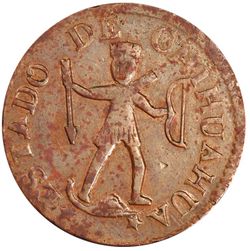
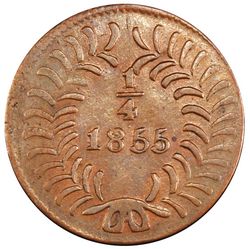
KM 342 ¼r 1855 Chihuahua
In this presentation, I investigate the ethnic and political significance of the native figure on the copper fractionals of Chihuahua from the First Republic (1833-56). All these coins follow the same general model: one side presents a man who looks indigenous, standing on the ground, in frontal view, with legs akimbo, wearing a plumed head-dress and skirt, waist cloth, or tunic, with his arms extended, a bow in his left hand, an arrow in his right (pointed down, which can signal peace), and a quiver on his back, while the legend not only indicates the issuer but it also encircles and seems to mark the figure as an emblem of “Chihuahua”. The other face consists of a wreath of leaves that wraps around the denomination, in a fraction of a real, above the date.
Variations over time
The legend varies only slightly in wording over the denominations and issues. The coins were issued in both octavos and cuartillas (eighths and quarters of a real), in 1833 to 1835, 1846, and 1855 to 1856. During this time, the legend changed from “Sovereign State of Chihuahua” and “Free State of…” to simply “State of…” and “Department of…” The earlier legends and releases, shortly after independence, emphasized not just Chihuahua’s identity but its autonomy but as Chihuahuan sovereignty was secured, this concern appears to have diminished.

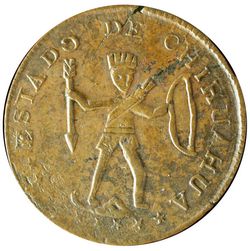
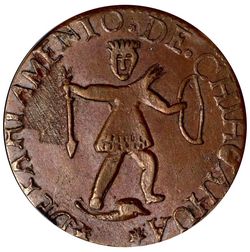
1833 cuartilla, “ESTADO SOBERANO” 1855 octavo, “ESTADO” 1855 cuartilla, “DEPARTAMENTO”
The figure and wreath remained largely the same throughout their usage, differing but slightly in a few details, mainly the:
• degree of extension of the figure’s arms
• configuration of the feathers of the head-dress (erect or laid back)
• use of skirt or tunic versus waist cloth (feathers or fabric?)
• inclusion or omission of the shoulder strap of the quiver, waist belt, and navel
• length and width of the wreath’s leaves, which shift over time from palm frond-like to laurel-like (or peace to victory?)
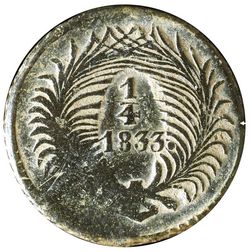

1833 cuartilla, palms 1855 cuartilla, laurels? for victory?
The Allegory of America
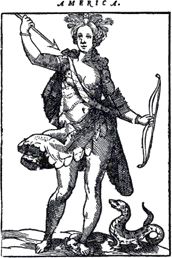 The native figure on Chihuahuan coins is based on the colonial-era allegory of the Americas, of the four continents and races. During the 16th Century in Europe, the figure of an indigenous woman was developed to personify America: Ripa (1603), image above, formalized its attributes, like feathered headdress and skirt, quiver, and bow and arrow in the hands, whilst a masculine version was also elaborated, as appears on Nolin’s (1755) world map. Adopting this image on its coppers depicted Chihuahua as American (not European), savage, and war-like.
The native figure on Chihuahuan coins is based on the colonial-era allegory of the Americas, of the four continents and races. During the 16th Century in Europe, the figure of an indigenous woman was developed to personify America: Ripa (1603), image above, formalized its attributes, like feathered headdress and skirt, quiver, and bow and arrow in the hands, whilst a masculine version was also elaborated, as appears on Nolin’s (1755) world map. Adopting this image on its coppers depicted Chihuahua as American (not European), savage, and war-like.
The male America was introduced to numismatic media on several medals of Spain and New Spain at the end of the colonial period. It was born in the form of a child who represented New Spain on the reverse of a medal from 1788 that grieved the death of Spanish Emperor Charles III and matured, it reappeared on the reverses of two medals from 1812 and 1814, celebrating the constitution of Cádiz and the election of a new Archbishop of Mexico The medals conveyed the allegory to Mexican mintage, where Chihuahua embraced and adapted it as an avatar.

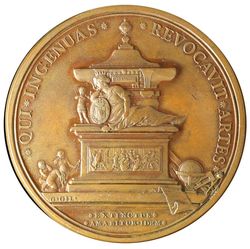
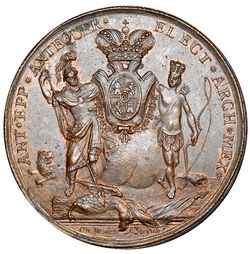
1788 the death of Charles III 1812 the Constitution of Cádiz 1814 the election of the Archbishop
Caste paintings and Chichimec portraits
The image also recalls caste paintings and Chichimec portraits. In the 1700s, Mexican artists often painted the races and mixes or castas. The native males resemble and could have inspired this coin figure, as seen in examples from the Museum of America in Madrid, where the indigenous male is semi-nude, wearing headdress and skirt of feathers, quiver and bow, with a woman carrying two children, walking through nature. The titles — “Wild, Barbarian Indians” and “Apache Indians” — extol the native stereotype as untamed, savage, and free.
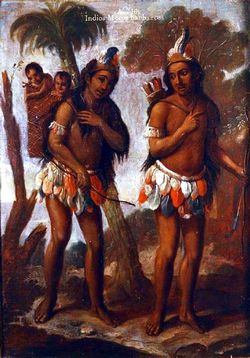

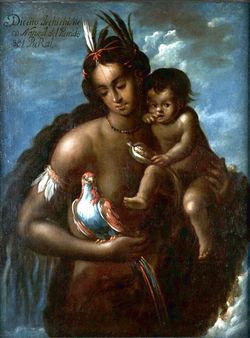
“Indios Mecos barbaros (Wild, Barbarian Indians)” “Diceño de chichi Meco, Natural del partido del PaRal” “Diceño de chichi Meca, Natural del partido del PaRal”
A pair of caste paintings from 1711 also in Madrid’s Museum of America — by Manuel Arellano, originator of the genre— stands out. The image of Chichi Meco [“wild], Native of the area of PaRal [sic, Chihuahua]” consists of a male bearing a headdress of feathers, waist cloth and quiver, bow and arrow, with a matching painting of a woman and child, hinting at the Madonna. It recalls the Chichimecs, ancestors of the Aztecs and in 19th Century Mexico symbolic of wild, savage, and beyond civil dominion, independent, a state which Chihuahua had only just realized.
Among the Chichimecs, the Chihuahua figure most resembles the native Rarámuri of the Tarahumara Mountains, alongside Parral. They wear a ritual head-dress with turkey feathers that looks a lot like the ones on the coins; traditionally, Rarámuri men also wore waist cloths or tunics in much the same style as the figure. The Rarámuri are legendary for their ferocity, resistance to conquest, and autonomy, particularly their great warrior Teporaca, an indigenous hero memorialized even today by Chihuahuans.
Native Allies
It could also be that the indigenous figure on the Chihuahua coins honors or thanks the numerous natives who sided with the revolutionaries and fought against the Spaniards during the Mexican war of independence. The indigenous Mexicans frequently lacked modern arms but had thousands of warriors, indispensable for victory, and many were traditional enemies of the Spaniards, with centuries of grievances and (often successful) resistance. They also had intimate knowledge of the landscape and considerable expertise at guerrilla warfare.
Indigenous Coinage
The use of the native figure on fractional coinage may not have been an accident. Such low-value coins would actually have reached the modest hands of the very same indigenous people they portrayed. The crude, rough character of the stick-like figure may also be significant. The Chihuahua mint had access to more refined production, as attested by its high-caliber 8-reales silver coins, but the mint may have been unwilling to invest similarly in copper fractionals.
“Madre Mexica”
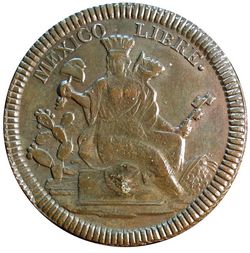 The Chihuahua figure is related to another on medals and coins from San Luis Potosí. “Madre Mexica” appears on a medal and fractional coppers from San Luis Potosí during the same First Republic, between 1828 and 1862, when the French invaded. (image left). This indigenous figure, again derived from the allegory of America, is seated on a pedestal, wearing a huipil and plumed crown, with Aztec sword, quiver, and arrow topped by a Phrygian cap of Liberty. The legend “Free Mexico” marks her as Mexican Liberty.
The Chihuahua figure is related to another on medals and coins from San Luis Potosí. “Madre Mexica” appears on a medal and fractional coppers from San Luis Potosí during the same First Republic, between 1828 and 1862, when the French invaded. (image left). This indigenous figure, again derived from the allegory of America, is seated on a pedestal, wearing a huipil and plumed crown, with Aztec sword, quiver, and arrow topped by a Phrygian cap of Liberty. The legend “Free Mexico” marks her as Mexican Liberty.
Pan-American
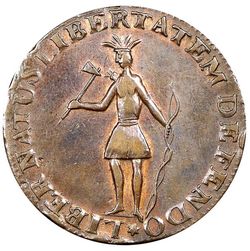 The Mexican figure forms part of a trans-American phenomenon that involved recently independent countries, from north to south. A similar figure adorns the “excelsior”state copper from New York in 1787, in the wake of independence. It bears a plumed headdress, skirt, and bow with quiver, plus a tomahawk in the right hand, also based on the allegory of America from the colonial epoch, and is surrounded by the legend “LIBER NATUS LIBERTATEM DEFENDO” or “born free, I defend liberty,” affirming that the native figure signals ferocity and autonomy.
The Mexican figure forms part of a trans-American phenomenon that involved recently independent countries, from north to south. A similar figure adorns the “excelsior”state copper from New York in 1787, in the wake of independence. It bears a plumed headdress, skirt, and bow with quiver, plus a tomahawk in the right hand, also based on the allegory of America from the colonial epoch, and is surrounded by the legend “LIBER NATUS LIBERTATEM DEFENDO” or “born free, I defend liberty,” affirming that the native figure signals ferocity and autonomy.
Conclusions
This brief review of the Chihuahuan figure and its relations leads us to conclude that:
• it is derived from the allegory of America of the four continents and races
• the personification of America was introduced to numismatic media by means of late Novo-Hispanic medals
• the Chihuahuan figure is also related to the indigenous depictions in the caste paintings
• in particular, it looks a lot like the Chichimec of Parral, Chihuahua in the oil painted by Arellano
• among the Chichimecs, it could very possibly represent a Rarámuri warrior or hunter-gatherer
• indeed, it is reminiscent of Teporaca, the great Rarámuri warrior still celebrated even today in Chihuahua
• plus, it could honor or thank the indigenous allies in the war of independence
• it is the masculine version of native Liberty (“Madre Mexica”) in the coppers of San Luis Potosí
• as it is the Mexican version of the similar figures that adorn the coins of other countries recently liberated, like the Excelsior copper of New York.
